Almost all AMD processors models 2009 - early 2010 are built on the basis of the K10.5 architecture. It has the following main features:
- process technology - 45 nm SOI;
- core area - 243 mm 2;
- number of transistors- about 705 million;
- voltage - 0.875-1.5 V;
- Socket-AMZ (941 pin).
Despite the external similarity and compatibility according to the processor socket standard (AM2+ or AMZ), the AMD line includes several completely different families in terms of positioning and characteristics, and it is not so easy to understand this abundance.
AMD processors
Unlike the Intel line we have already reviewed (Core i7, i5, i3, Pentium), in the assortment of mass AMD processors only two families stand out (not counting the Operton server line) - Phenom II and Athlon II. However, inside they are much more complicated: in each family you can find AMD processors with four, three and two cores (and in 2010 the first six-core processor was added to them). This allows for clearer segmentation, but makes it much more difficult for consumers to choose. Is it possible on the fly, focusing only on the numerical index and prices, to understand which is faster: a dual-core Phenom II processor at 2.6 GHz or a triple-core Athlon II at 3 GHz, but with no L3 cache?
It is worth shedding light on two more points: the performance and overclocking of AMD processors in comparison with Intel. The discussion on this topic is clearly among the endless, and the final conclusion can not be drawn. However, the following is obvious: Intel processors are undoubtedly technologically more advanced, but AMD clearly wins in terms of price / quality ratio (at least in the middle price segment). Despite the fact that the Core i7 provides some performance gains in archiving, video or audio compression, in gaming tests and office applications AMD processors show almost equal results with Intel.
As for overclockability, the technological gap between AMD and Intel, alas, makes itself felt: AMD processors of the middle and lower price categories overclock quite decently, but in the higher segment the picture is not so rosy - increased heat dissipation (up to 125 W versus 90-95 W at Intel) prevents serious overclocking.
It is necessary to mention one more overclocking possibility, peculiar exclusively to AMD processors: some models of two- and three-core Phenom II and Athlon II are in fact ordinary quad-core crystals, the "extra" cores in which are simply disabled. With some simple tricks (such as BIOS settings), you can try to activate these cores, resulting in a high-end processor. True, this is far from always possible, moreover, often disabled kernels are simply defective.
AMD Processors: Phenom II Family
Unlike Intel, which changed several architectures and almost a dozen cores in two years, the lineup AMD is more stable: for several years AMD processors have been based on the same K10 architecture (its latest modification is called K10.5).

Phenom II family
Probably the last line of processors built on the basis of this architecture (before the transition to a fundamentally new core in 2010) was the Phenom II family. The main difference between the new Phenom II processors and the AMD Phenom family is that they are made using a 45-nanometer process technology using SOI technology, while AMD processors The Phenom families are made using the 65nm process technology.
Just like the AMD Phenom X4 family models, they are true quad-core AMD processors , that is, all four cores are made on the same chip. Each Phenom II X4 processor core has a dedicated 512 KB L2 cache and a 6 MB L3 cache shared between all cores. Recall that in processors of the Phenom X4 family, the size of the L3 cache was 2 MB.
AMD Phenom II X4 processors, like AMD Phenom X4, are compatible with AM2+ sockets (although the main focus is on the new AMZ socket) and support the HyperTransport 3.0 bus at speeds up to 3600 MHz (two-way) with throughput up to 16 GB/s.
Processors of the Phenom II X4 family have an integrated dual-channel DDR2 memory controller and support DDR2-667/800/1066 memory (in 2009 models - DDR3-1066/1333).
Among the innovations in the new AMD Phenom II X4 processors, we can also note the improved Cool "n" Quiet 3.0 technology. It combines a number of features to reduce the power consumption of the processor in those moments when it is underloaded, as well as to prevent the processor from overheating. Indeed, what is the difference this technology from Cool "n" Quiet 2.0, which was implemented in AMD Phenom X4 processors, company representatives do not specify.
When announcing the new processor of the Phenom II X4 family, AMD also pointed out other advantages compared to the previous family. In particular, it was noted that new AMD processors execute more instructions per clock (IPC). True, no details were reported about the changes in the microarchitecture of the processor that increase the IPC. After all, it is obvious that an increase in either the clock frequency or the size of the L3 cache cannot affect the increase in IPC. So either the microarchitecture of the processor has been changed, which AMD is silent about, or the increase in IPC is a marketing statement that has nothing to do with reality.
The AMD Phenom II processor family currently includes two modifications - x3 (three nuclear processors) and x4 (quad-core). Most of the latter are built on the well-tuned Agena core, familiar from the old Phenom processors. However, the new models of the highest price category are based on the improved Deneb core, which consumes significantly less power (from 30 to 50%) with an increased third-level cache. The Deneb core (Shanghai) is a 45nm K10.5 generation processor. It consists of about 758 million transistors and has an area of 243 mm 2 (against 463 million and 283 mm 2 for 65-nanometer Barcelona and 731 million and 246 mm 2 for Nehalem), it has an increased L3 cache (from 2 to 6 MB), and also minor architecture optimizations.
In 2010, AMD plans to release AMD's first six-core processor codenamed Thuban (Phenom II X6). Like the existing Phenom II chips, the processor will be manufactured using 45nm technology and designed for the AM2+/AM3 socket. The integrated DDR3 memory controller will be able to operate at 1333 MHz, and the L2 cache size will be 3 MB with 6 MB of L3 cache. The company's future plans include accelerated development of 32-nanometer standards together with IBM.
It remains to be added that all Phenom II processors released in the second half of 2009 are actually created on a single Deneb platform and differ only in the number of cores.
Let's decipher the marking of Phenom processors using the example of HDZ940XCJ4DGI:
- H - brand: Phenom (for Athlon processors it would be the letter A);
- D - segment: desktop processor;
- Z - Black Edition: unlocked^ multiplier (for locked - the letter X);
- 940 - model;
- XC - series: 125 W, desktop, 2nd power supply (other TDPs: D - 35 W, H - 45 W, O - 65 W, A - 89 W, W - 95 W, X - 125 W);
- J - packaging: AM2g2 (corresponds to AM2+);
- 4 - number of cores: 4 (sometimes 3 or 2);
- D - cache size: L2 512 KB per core and total L3 6 MB (B means L2 512 KB per core and total L3 2 MB);
- GI - revision: C2 (for other models: GD - revision B2, GH - revision OT).
Characteristics of processor models built on Deneb, Heka and Callisto cores are given in Table. 1.11-1.13. MMX, SSE, SSE2, SSE3, SSE4a, Enhanced 3DNow!, NX bit, AMD 64, Cool "n" Quiet, AMD-V technologies are supported. Memory - DDR2 SDRAM, DDR3 SDRAM.
As in the case of Intel products, we see a clear division into segments: dual-core AMD processors (office), tri-core x3 ( budget niche), the x4 series for more powerful computers and "luxury" Black Edition processors in every niche. The latter, like the Core i7 Extreme Edition, are distinguished not only by an increased L3 cache, but also by an unlocked multiplier, which provides good overclocking opportunities.
AMD Processors: Athlon II Family
In parallel with Phenom II, AMD supports another line of processors based on the AMD K10 architecture - Athlon I. In fact, this series has replaced the ultra-budget (up to $1100) Sempron line. Unlike Phenom, these AMD processors are deprived of L3 cache, however, as compensation, they are equipped with double L2 cache (1 MB for each core). In addition, the Athlon II series has significantly lower heat dissipation compared to the Phenom II.

Athlon II family
Tests show that at the same frequency and with the same number of cores Athlon processors II lag behind their Phenom II counterparts by no more than 10%, and in some cases go head to head with them. With over a 50% difference in price and excellent overclocking potential, these models can be safely recommended to budget-minded users who want to get the most performance for every dollar invested.
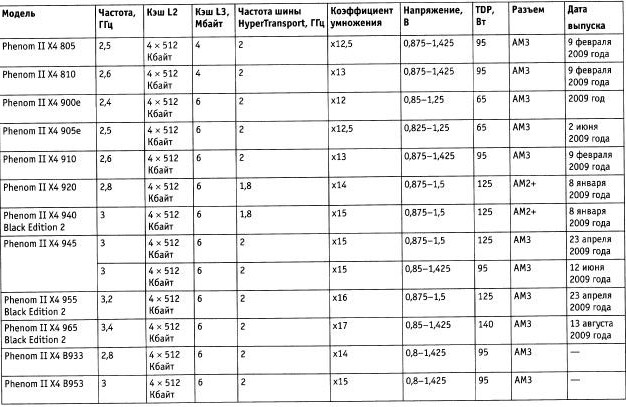

Processors built on the Deneb core (C2, 45 nm, four cores)

Processors built on the Callisto core (C2/C3, 45 nm, two cores)

Processors built on the Propus core (C2, 45 nm, four cores)

Processors built on the Rana core (45 nm, three cores)
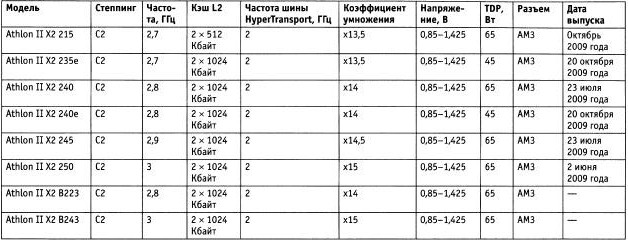
Processors built on the Regor core (45 nm, two cores)
Before processors AMD Ryzen™ there is not much time left, and many today are wondering about the future of AMD FX™ processors. In the end, it is Ryzen that will receive the status of the latest AMD processor, it will change the processor market and open up new opportunities for both gamers and professional users. A powerful ecosystem is already in full swing, and by all accounts, Ryzen will be one of the most anticipated and successful AMD products ever.
AMD FX processor: what is its role in the market today?
In 2017, AMD FX processors will ship to market alongside new AMD Ryzen processors; both processor lines will be available to consumers as the market continues to demand DDR3 platforms in both mainstream and high-end price segments.
AMD FX processors currently deliver the highest clock speeds in desktop PCs for ordinary users. The number of cores in them is at least twice the number of cores in competitor processors in the same price categories. 1.2 And unlike competitor products, all AMD FX processors come with an unlocked frequency multiplier, giving users the freedom to customize performance and power consumption using AMD OverDrive™ software. 3
Modern games are increasingly supporting low-level APIs and using more threads. That's why AMD's commitment to offering users more processor cores at a given price point is designed to ensure competitive system performance in the latest gaming titles. In terms of AMD development, AMD FX processors continue to represent a strong and competitive product line.
What's more, as more multi-core-intensive games hit the market, AMD FX processors are getting more efficient and relevant, with more cores and higher performance. clock frequency. In conclusion, let's analyze how AMD FX processors will coexist with Ryzen processors? While it is already clear that AMD Ryzen processors will also feature high clock speeds like AMD FX processors, it should be borne in mind that the AMD FX and Ryzen lines are aimed at different consumer segments.
Unlike AMD Ryzen, AMD FX processors do not target the enthusiast and professional user segment. AMD Ryzen completes the current line of AMD processors. At recent "Path to Zen", "New Horizon" and CES events, AMD demonstrated that Ryzen processors keep up with the competition and even, in some cases, outperform them in games, professional applications and game streaming, which is quite consistent with the requirements of true gamers and professional users.
Who, then, are AMD FX processors aimed at?
Although many system integrators and assemblers prefer to use all the latest advanced hardware in their configurations, they cover only one segment of the consumer market - enthusiasts of high-performance solutions.
Many users simply want powerful and reliable processors at an affordable price, and there is little that can compare with AMD FX.
The AMD FX processor is a great solution for both designers and developers who multi-core processors needed to support the latest graphic applications And virtual machines, and for ordinary users for whom the potential of the processor is important for games and standard applications. It should also be noted that it is the 8-core AMD FX ™ 8350 that is recommended to be used as a processor for the platform virtual reality based on HTC VIVE. 4
So, in the foreseeable future, AMD FX processors should not be written off.
AMD FX processors are among the most powerful and reliable AMD processors, and they do not lose their relevance. Offering high performance at an exceptionally affordable price, AMD Ryzen processors are no competitor to AMD FX. These new processors rather complement AMD's product development plan.
As such, AMD Ryzen and AMD FX processors will co-exist in the marketplace, offering consumers a flexible range of solutions to suit their budget and needs.
- AMD FX™ 9590 has the highest rated (4.7 GHz) and turbo frequency (5.0 GHz) among all models CPUs x86 desktop. The nominal clock frequency and turbo frequency of the fastest Intel i7-4790K processor is 4.0 GHz and 4.4 GHz, respectively. Competitor products are listed at ark.intel.com. DTV-34
- As of August 29, 2016, AMD FX™ 4000 series processors ($90 to $110) have 4 cores, while AMD FX™ 4000 series processors Intel Pentium G and Core i3 6100 series ($60 to $126) have 2 cores; AMD FX™ 6000 series processors ($100 to $139) have 6 cores, while processors Intel Core i3 6300 series ($150 to $160) have 2 cores; AMD FX™ 8000 and AMD FX™ 9000 series processors ($120 to $205) have 8 cores, while Intel Core i5 6000 series processors ($190 to $250) have 4 cores. Pricing information is based on Newegg.com data as of 08/29/2016. Competitor products are listed at ark.intel.com. DTV-77
- AMD FX™ product warranty does not cover damage caused by overclocking the processor, even if overclocked using hardware AMD.
- HTC has listed the AMD FX™ 8350 processor as one of the recommended computer hardware for use with VIVE (
I recently wrote about the history of the development of Intel processors. For those who are interested, this article can be found at the link:. When I wrote the article, I became very interested in how AMD processors developed. Now everyone who is in the subject knows that AMD is the main and eternal competitor of Intel.
On a note! In today's article, I will try to write all the branches of development of AMD processors. If you write about each processor in detail, then the article will be insanely large, in connection with which I decided to write the most necessary and add photos with detailed characteristics.
1. AMD Am 2900 processor(1975)
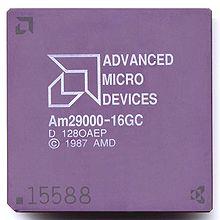
This processor is the ancestor of the AMD processor. It was originally made for computers (calculator). The processor itself was 4-bit, but it had one big disadvantage: the processor needed a large area for integrated circuits. Over time, this problem was solved.
After some time, this processor had a whole family from 2900 to 2965. Latest Versions processors had good power.
2. AMD Am 9080 processor(1974)
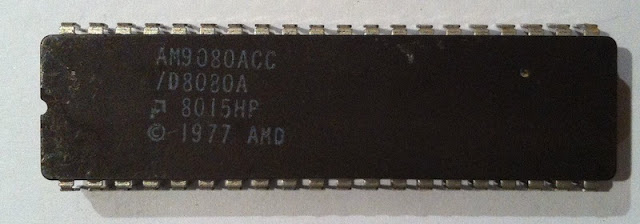
The clock frequency of the processor was 2 MHz. In fact, it was a clone of the Intel 8080 processor. It was even released without a license.
3. AMD Am 286 processor(1982)

This processor was produced under license from Intel and was a clone of the Intel 80286 processor. But unlike Intel, it had several significant advantages:
1. High clock speed
2.EMS emulation
3. Ability to exit Protected mode
4. Low price

4. AMD Am 386 processor(1991)
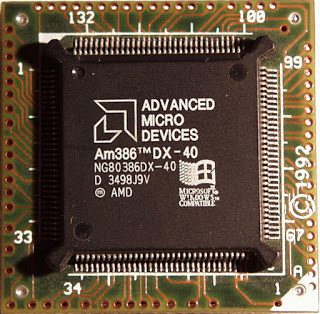
This processor was also identical to the Intel processors. With the release of this processor, AMD continued to review the production of clones of Intel processors.
The Am 386 processor had 2 interesting features:
1. It was much faster than the Intel counterparts
2. This is the first processor to get a logo Windows Compatible
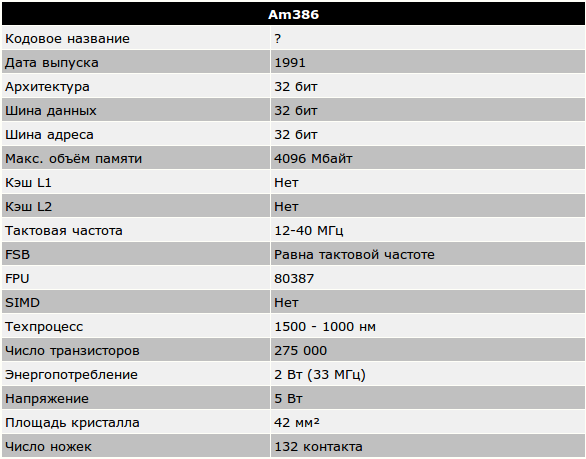
5. AMD Am 486 processor(April 1993)

This was latest processor, which became an Intel clone. It was made to compete with the Intel 80486 processor. Then this processor began to be released in two versions: the first version of the processor had Intel microcode, and the second one had AMD microcode. With the introduction of its microcode, AMD had a conflict with Intel.
Later this processor was upgraded to AMD 5x86. This is the same Am 486 processor, only with a 4x multiplier.
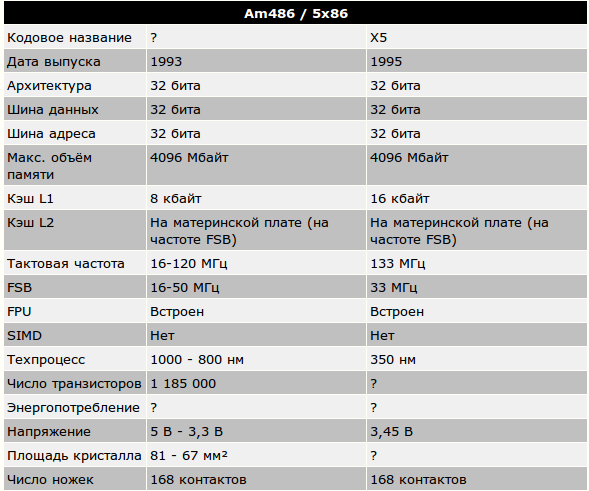
6.AMD K5 processor(1996)
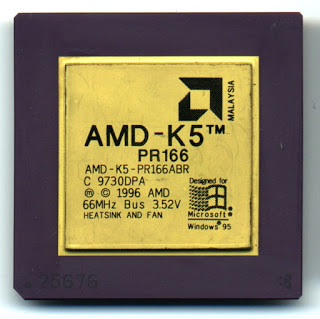
This is AMD's first proprietary processor. The K5 processor was the fifth generation and, if compared with the Intel Pentium, it was more advanced, albeit with minor flaws.
At that time, the AMD K5 processor was very interesting for its internal architecture, made on the basis of RISC. This architecture decoded before executing the x86 instructions in the microinstruction.
On a note! This is the first processor that was written on the packaging that installation is required radiator And fan. Such a cooling system was extremely rare at that time.
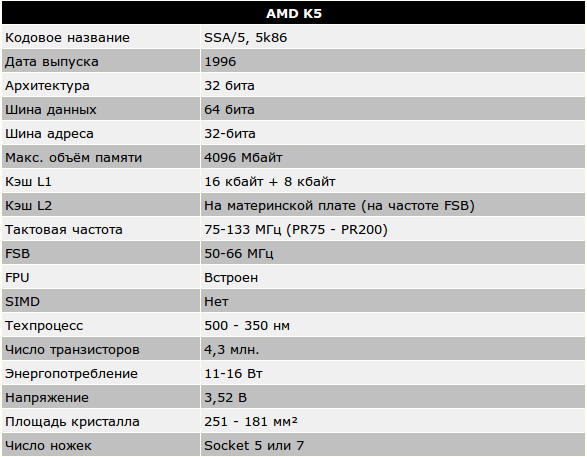
7.AMD K6 processor(1997)

This processor is the result of NexGen's work on the Nx686. The AMD K6 processor was compatible with motherboards Socket 7 (Pentium). And to all this, he worked better with this board than the Intel Pentium II processor. And yes, it was much cheaper.
In 1998, the K6 processor was upgraded to the K6-2 processor. It already used a faster bus (100 MHz) and increased SIMD performance.
In 1999, the third version of the K6-3 processor was introduced. In terms of its characteristics, it surpassed the K6-2 processor, but only in production it was very expensive.
On a note! In the same year, AMD began selling processors for laptops. Versions of the K6-3+ and K6-3+ processors were both manufactured using the 180nm process technology.

8.AMD K7/Athlon processor(1999)

Since the K6-3 processor could no longer be upgraded, AMD decided to release new processor seventh generation K7. Later it was renamed to Athlon.
All flaws have been eliminated in this processor previous versions. In this regard, the processor was superior to the processors of the Intel line. In the people, this processor was immediately called "Intel KILLER".
At that time, the Athlon processor was the most fast processor x86. True, there was one problem on the part of the chipset. Neither of AMD chipsets and VIA couldn't compete with Intel's chipsets.
On a note! This year, AMD was the very first to announce and sell a 1GHz processor, beating Intel by a full two days.
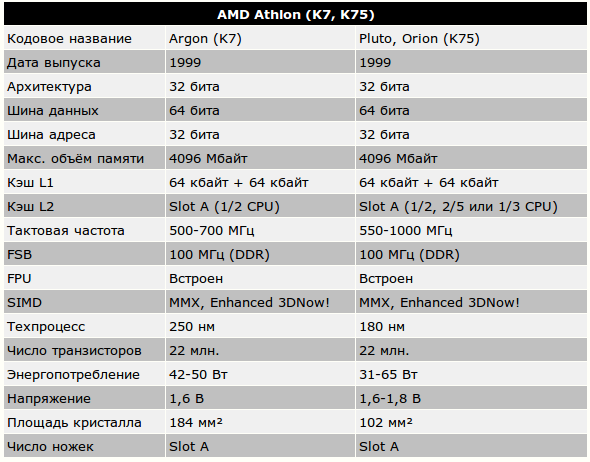
9. AMD Athlon processor: Thunderbird, XP, Barton(summer 2000)

Since AMD came out on top with the K7 processor, they decided to improve it step by step. In the next versions of the processors, the frequency was increased and a transition was made to thinner technical processes.
Do not forget that AMD also made processors for servers and laptops.
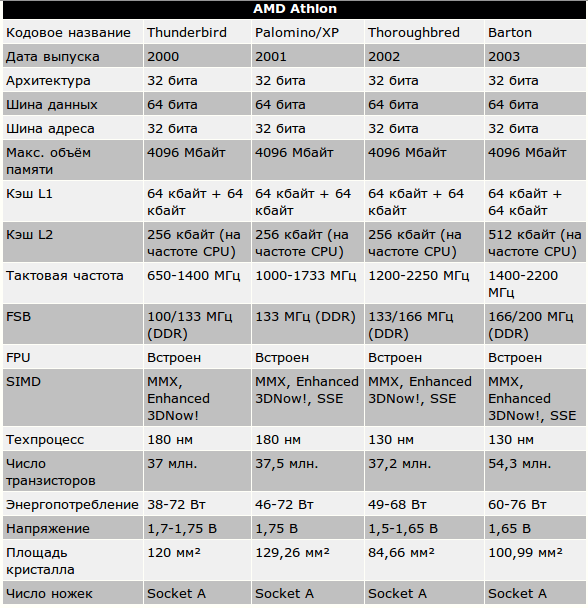
10. AMD Duron and Sempron Processor (2000 - 2004)

To compete with Intel processors, Celeron AMD released two budget processors. Of course, they were slower than Athlon processors, but they still competed with Celeron.
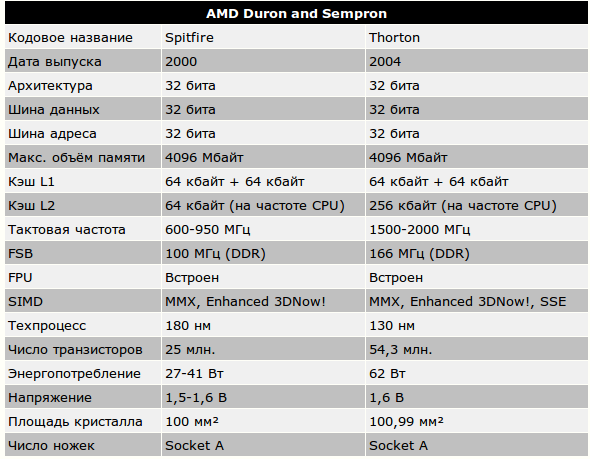
11.AMD K8 processor(2003)
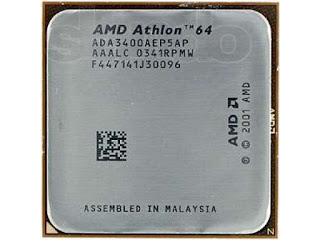
The eighth generation AMD K8 processor was the first x86 processor to support 64-bit addressing. The main improvement of the processor was the integrated memory controller.
After that, AMD released a huge number of processors based on the K8 processor. As an example, I want to bring to your attention a couple of processors: Opteron(server version), Turion 64(for laptops) and Athlon 64FX(High-end processor).

12. AMD Athlon 64 X2 processor(2005 year)

This processor was created from two cores of the K8 processor, becoming the first dual-core AMD processor. Thanks to the architecture with the Hyper Transport interface, performance has been significantly increased. At that time, it was significantly ahead of Intel processors.
The processor also had many modifications, like the previous processor. It was sold until 2008, then lost its relevance.

13. AMD Phenom Processor: K10 and Quad-Core(2007)
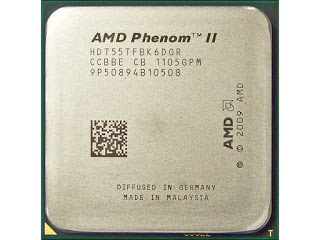
The architecture of this processor was well developed. With the release of the K10 processor, AMD faced severe problems. The processor was not as fast and was difficult to overclock. Here Intel significantly outperformed AMD.
Further, the Phenom processor was modified to 4 cores and became known as Phenom X4, but even then there were problems with the 4th core, because it was defective. Then came the 3-core Phenom X3 processor.
Unfortunately, by mid-2008, it was becoming very difficult for AMD to compete with Intel. In order to get out of the situation it was necessary to offer new solutions.
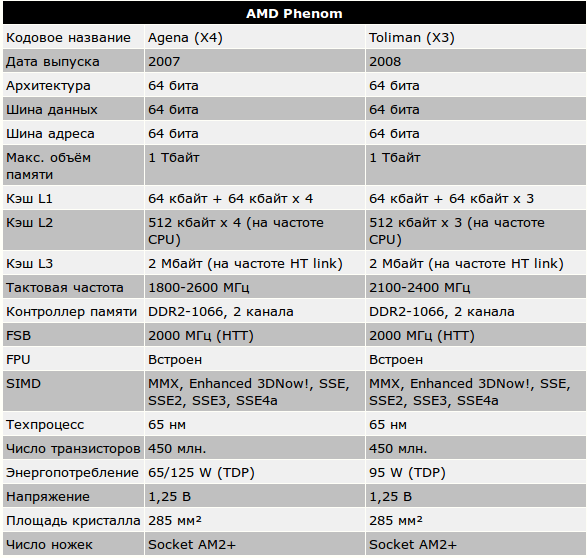
14. AMD Bulldozer Processor(2010)
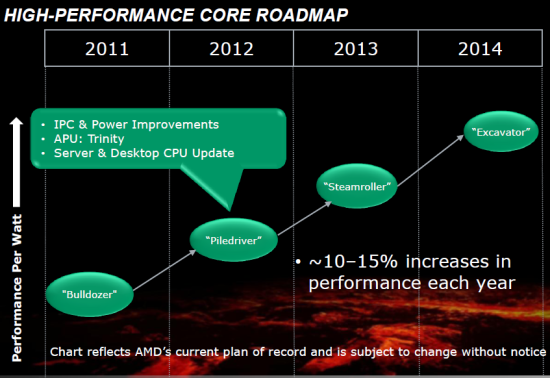
To get out of the crisis (a solid gap from Intel), AMD has developed a completely new architecture. AMD has given its new processor a code name "Bulldozer". The name, most likely, was not chosen by chance. This processor was supposed to demolish Intel processors from the market like a bulldozer demolishes everything in its path.
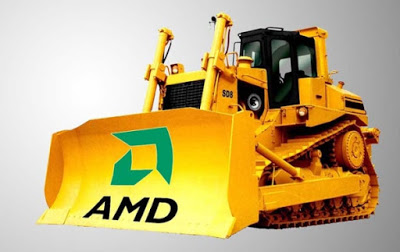
This processor is divided into two branches: Opteron (server version) and FX (for PC). The photo should be clear. This processor has made excellent competition to Intel Core processors. They are still sold to this day and are on a par with Intel processors.

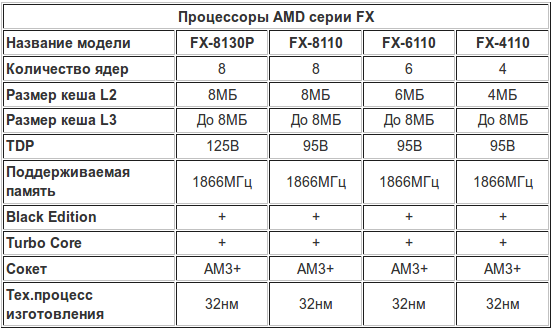
Output
So the history of AMD processors has ended, but perhaps in a couple of years someone else will finish this article.Finally, I want to present you an article where I described the advantages and disadvantages of AMD and Intel processors. To go to the article, click here:
The processor is the main component of the computer, nothing will work without it. Since the release of the first processor, this technology has been developing by leaps and bounds. The architectures and generations of AMD and Intel processors have changed.
In one of the previous articles, we considered, in this article we will look at the generations of AMD processors, consider how it all started, and how it improved until the processors became what they are now. Sometimes it's very interesting to understand how technology has evolved.
Generations of AMD processors
As you already know, initially, the company that produced processors for the computer was Intel. But the US government did not like that such an important part for the defense industry and the country's economy is produced by only one company. On the other hand, there were others who wanted to release processors.
AMD was founded, Intel shared with them all its developments and allowed AMD to use its architecture to release processors. But this did not last long, after a few years Intel stopped sharing new developments and AMD had to improve their processors themselves. By the concept of architecture, we will mean microarchitecture, the arrangement of transistors on a printed circuit board.
Early processor architectures
First, a brief look at the first processors produced by the company. The very first was the AM980, it was full of an eight-bit Intel 8080 processor.

The next processor was AMD 8086, a clone of Intel 8086, which was produced under a contract with IBM, because of which Intel was forced to license this architecture to a competitor. The processor was 16-bit, had a frequency of 10 MHz, and the 3000 nm manufacturing process was used for its manufacture.

The next processor was a clone of Intel 80286 - AMD AM286, compared to the device from Intel, it had a higher clock frequency, up to 20 MHz. The process technology has been reduced to 1500 nm.
![]()
Next was the AMD 80386 processor, a clone of Intel 80386, Intel was against the release of this model, but the company managed to win a lawsuit. Here, too, the frequency was raised to 40 MHz, while Intel had only 32 MHz. The technical process is 1000 nm.

AM486 is the latest processor released based on Intel's developments. The processor frequency was raised to 120 MHz. Further, due to litigation, AMD was no longer able to use Intel technologies and they had to develop their own processors.
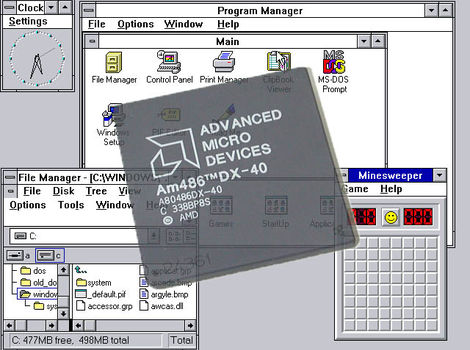
Fifth generation - K5

AMD released its first processor in 1995. It had a new architecture that was based on the previously developed RISC architecture. Ordinary instructions were recoded into microinstructions, which helped to greatly improve performance. But here AMD could not bypass Intel. The processor had a clock speed of 100 MHz, while the Intel Pentium was already running at 133 MHz. For the manufacture of the processor, the 350 nm process technology was used.
Sixth generation - K6
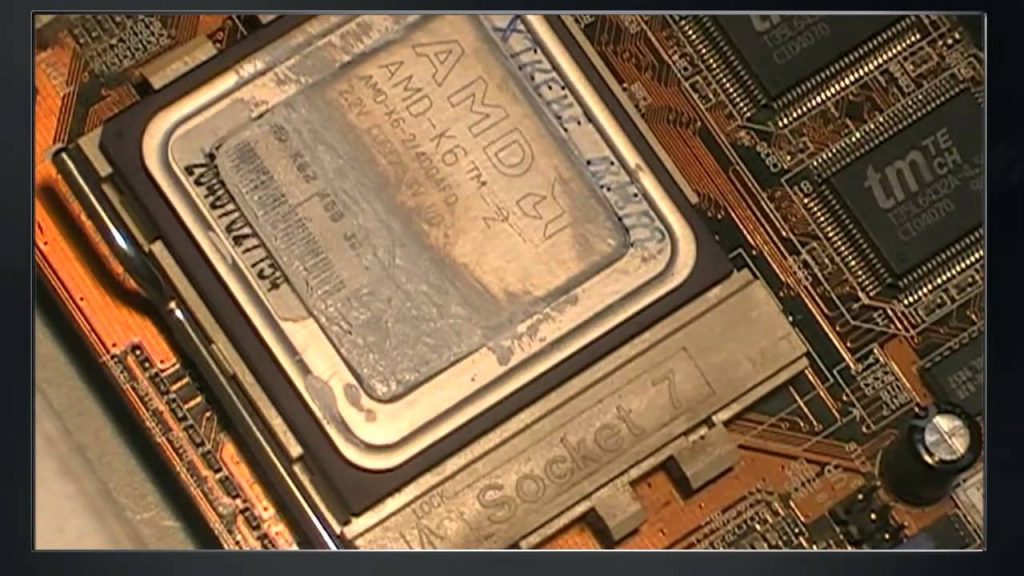
AMD did not develop a new architecture, but decided to acquire NextGen and use its Nx686 developments. Although this architecture was very different, it also used instruction conversion to RISC, and it also did not bypass the Pentium II. The processor frequency was 350 MHz, the power consumption was 28 watts, and the manufacturing process was 250 nm.
The K6 architecture had several improvements in the future, several sets were added to the K6 II additional instructions, which improved performance, and the K6 III added L2 cache.
Seventh generation - K7

In 1999, a new microarchitecture of AMD Athlon processors appeared. Here, the clock frequency was significantly increased, up to 1 GHz. The second level cache was placed on a separate chip and had a size of 512 kb, the first level cache was 64 kb. For manufacturing, the 250 nm process technology was used.
Several more processors based on the Athlon architecture were released, in Thunderbird the second level cache returned to the main integrated circuit, which increased performance, and the process technology was reduced to 150 nm.
In 2001, processors based on the AMD Athlon Palomino processor architecture were released with a clock speed of 1733 MHz, a 256 MB L2 cache and a 180 nm process technology. Power consumption reached 72 watts.
Architecture improvements continued, and in 2002 the company launched the Athlon Thoroughbred processors, which used the 130nm process and clocked at 2GHz. Barton's next improvement increased the clock speed to 2.33 GHz and doubled the size of the L2 cache.
In 2003, AMD released the K7 Sempron architecture, which had a clock speed of 2 GHz, also with a 130 nm process technology, but already cheaper.
Eighth generation - K8
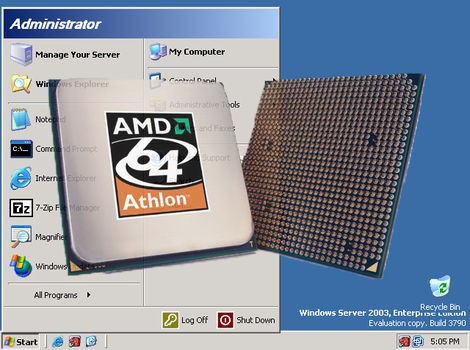
All previous generations of processors were 32-bit, and only the K8 architecture began to support 64-bit technology. The architecture has undergone many changes, now the processors could theoretically work with 1 TB of RAM, the memory controller was moved to the processor, which improved performance compared to K7. Also added here new technology HyperTransport data exchange.
The first processors based on the K8 architecture were Sledgehammer and Clawhammer, they had a frequency of 2.4-2.6 GHz and the same 130 nm process technology. Power consumption - 89 watts. Further, as with the K7 architecture, the company performed a slow improvement. In 2006, Winchester, Venice, San Diego processors were released, which had a clock speed of up to 2.6 GHz and a 90 nm manufacturing process.
In 2006, Orleans and Lima processors came out, which had a clock speed of 2.8 GHz, the latter already had two cores and supported DDR2 memory.
Along with the Athlon line, AMD released the Semron line in 2004. These processors had a lower frequency and cache size, but were cheaper. Frequency up to 2.3 GHz and L2 cache up to 512 KB were supported.
In 2006, the development of the Athlon line continued. The first dual-core Athlon X2 processors were released: Manchester and Brisbane. They had a clock frequency of up to 3.2 GHz, a 65 nm manufacturing process and a power consumption of 125 watts. In the same year, the Turion budget line was introduced, clocked at 2.4 GHz.
Tenth generation - K10

The next architecture from AMD was the K10, which is similar to the K8, but has received many improvements, including an increase in cache, an improvement in the memory controller, an IPC mechanism, and most importantly, a quad-core architecture.
The first was the Phenom line, these processors were used as server processors, but they had a serious problem that led to the processor freezing. AMD later fixed it in software, but this reduced performance. Processors were also released in the Athlon and Operon lines. The processors ran at 2.6 GHz, had 512 KB of L2 cache, 2 MB of L3 cache, and were manufactured using the 65 nm process technology.
The next architectural improvement was the Phenom II line, in which AMD made a process transition to 45 nm, which significantly reduced power consumption and heat consumption. Quad-core Phenom II processors had a frequency of up to 3.7 GHz, a third-level cache of up to 6 MB. The Deneb processor already supported DDR3 memory. Then the dual-core and tri-core Phenom II X2 and X3 processors were released, which did not gain much popularity and worked at lower frequencies.
In 2009 were released budget processors AMD Athlon II. They had clock speeds up to 3.0 GHz, but the third level cache was cut out to reduce the price. The lineup included a quad-core Propus and a dual-core Regor. In the same year, the Semton product line was updated. They also did not have an L3 cache and ran at a clock speed of 2.9 GHz.
In 2010, the six-core Thuban and the quad-core Zosma were released, which could run at 3.7 GHz. The processor frequency could change depending on the load.
Fifteenth generation - AMD Bulldozer
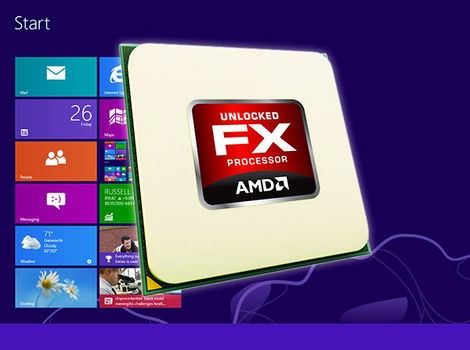
In October 2011, a new architecture came to replace the K10 - Bulldozer. Here the company tried to use a large number of cores and high clock speed to get ahead of Intel's Sandy Bridge. The first Zambezi chip couldn't even beat the Phenom II, let alone Intel.
A year after the release of Bulldozer, AMD released an improved architecture codenamed Piledriver. Here, clock speed and performance have been increased by about 15% without increasing power consumption. The processors had a clock speed of up to 4.1 GHz, consumed up to 100 W, and were manufactured using a 32 nm process technology.
Then the FX processor line was released on the same architecture. They had clock speeds up to 4.7 GHz (5 GHz when overclocked), were versions for four, six and eight cores, and consumed up to 125 watts.
The next Bulldozer improvement, the Excavator, came out in 2015. Here the process technology has been reduced to 28 nm. The processor clock speed is 3.5GHz, the number of cores is 4, and the power consumption is 65W.
Sixteenth generation - Zen

This is a new generation of AMD processors. Zen architecture was developed by the company from scratch. Processors will be released this year, it is expected that in the spring. For their manufacture, the 14 nm process technology will be used.
The processors will support DDR4 memory and generate 95 watts of heat. The processors will have up to 8 cores, 16 threads, clocked at 3.4 GHz. Power efficiency has also been improved, and automatic overclocking has been announced as the processor adjusts to your cooling capabilities.
conclusions
In this article, we looked at AMD processor architectures. Now you know how they developed AMD processors and how things are on this moment now. You can see that, some generations of AMD processors are omitted, these are mobile processors, and we intentionally excluded them. I hope this information was helpful to you.
For the first time, AMD processors appeared on the market in 1974, following the presentation by Intel of their first models of the 8080 type, and were their first clones. However, the very next year, the am2900 model of its own design was introduced, which was a microprocessor kit, which began to be produced not only by the company itself, but also by Motorola, Thomson, Semiconductor and others. It should be noted that the Soviet microsimulator MT1804 was also made on the basis of this kit.
AMD Am29000 Processors
The next generation - Am29000 - full-fledged processors that combined all the components of the kit into one device. They were a 32-bit processor based on the RISC architecture with an 8 KB cache. The release began in 1987 and ended in 1995.
In addition to its own developments, AMD also produced processors manufactured under license from Intel and bearing a similar marking. So, the Intel 8088 model corresponded to Am8088, Intel 80186 - Am80186 and so on. Some models were upgraded and received their own marking, slightly different from the original, for example Am186EM - an improved analogue of Intel 80186.
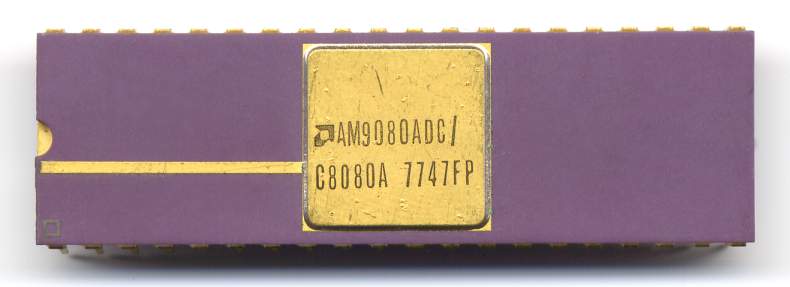
AMD C8080A Processors
In 1991, a line of processors was introduced, designed for desktop computers. The series was designated Am386 and used in its work the microcode developed for Intel 80386. For embedded systems, similar processor models were put into production only in 1995.
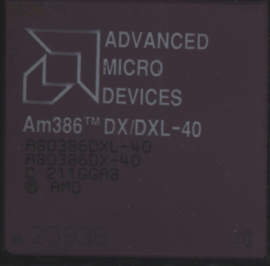
AMD Am386 Processors
But already in 1993, the Am486 series was introduced, designed for installation only in its own 168-pin PGA connector. The cache ranged from 8 to 16 KB in upgraded models. The family of embedded microprocessors was designated Elan.

AMD Am486DX Processors
K-series
In 1996, the production of the first family of the K series began, which received the designation K5. To install the processor, a universal socket was used, called Socket 5. Some models of this family were designed for installation in Socket 7. The processors had one core, the bus frequency was 50-66 MHz, the clock frequency was 75-133 MHz. The cache was 8+16 KB.
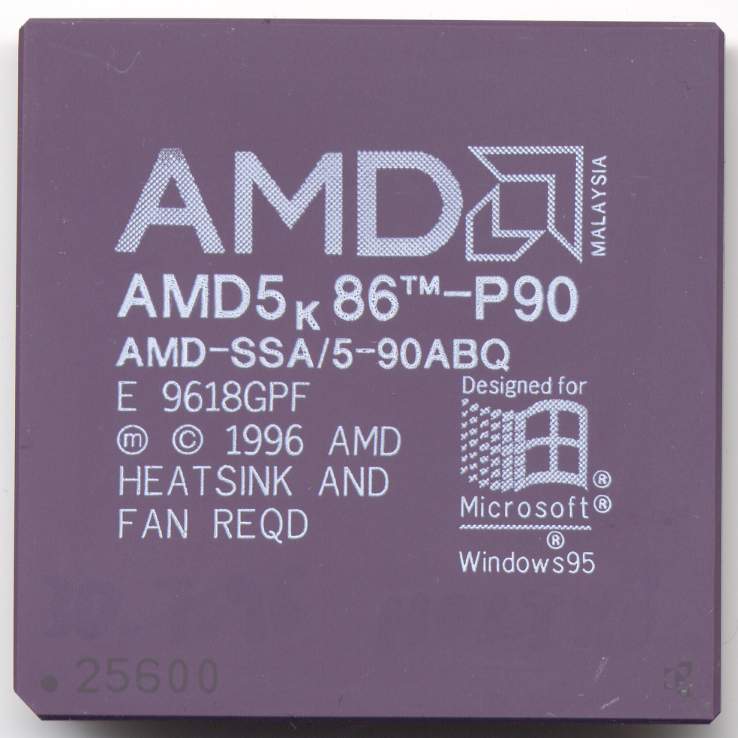
AMD5k processor series
The next generation of the K series is the K6 processor family. When they are produced, their own names begin to be assigned to the cores on which they are based. So, for the AMD K6 model, the corresponding code name is Littlefood, AMD K6-2 - Chomper, K6-3 - Snarptooth. The standard for installation in the system was a Socket 7 and Super Socket 7. The processors had one core and operated at frequencies from 66 to 100 MHz. The cache of the first level was 32 KB. For some models, there was also a second-level cache, 128 or 256 KB in size.

AMD K6 processor family
Since 1999, the release of Athlon models, included in the K7 series, has been widely used and well-deserved recognition of many users. In the same line are the budget models Duron, as well as Sempron. The bus frequency ranged from 100 to 200 MHz. The processors themselves had a clock frequency of 500 to 2333 MHz. Possessed 64 KB of cache in the first level and 256 or 512 KB of cache in the second level. The installation connector was designated as Socket A or Slot A. The release ended in 2005.
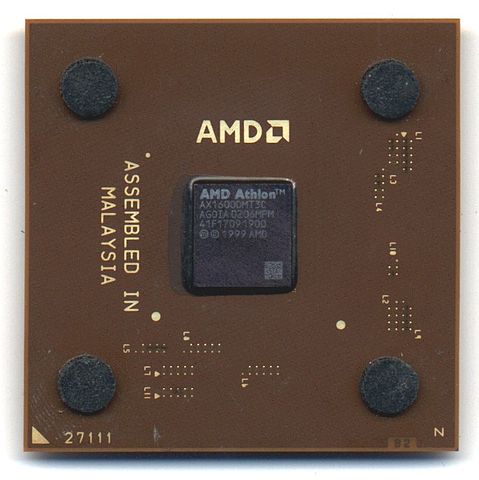
AMD K7 Series
The K8 series was introduced in 2003 and includes both single-core and dual-core processors. The number of models is quite varied, as processors have been released for both desktop and mobile platforms. Various connectors are used for installation, the most popular of which are Socket 754, S1, 939, AM2. The bus frequency is from 800 to 1000 MHz, and the processors themselves have a clock frequency from 1400 MHz to 3200 MHz. L1 cache is 64 Kb, L2 cache is from 256 Kb to 1Mb. An example successful use are some models of Toshiba laptops based on Opteron processors that have a code name corresponding to the code name of the kernel - Santa Rosa.
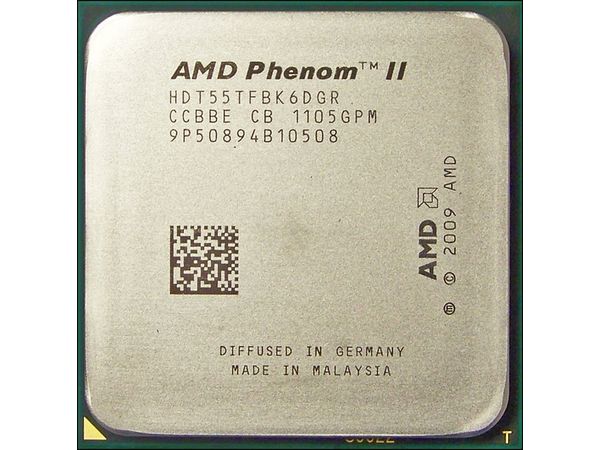
AMD K10 Processor Family
In 2007, the release of a new generation of K10 processors began, represented by only three models - Phenom, Athlon X2 and Opteron. The processor bus frequency is 1000 - 2000 MHz, and the clock frequency can reach 2600 MHz. All processors have 2, 3 or 4 cores depending on the model, and the cache is 64 KB for the first level, 256-512 KB for the second level and 2 MB for the third level. Installation is made in sockets of the Socket AM2, AM2+, F type.
The logical continuation of the K10 line is called K10.5, which includes processors with 2-6 cores, depending on the model. The processor bus frequency is 1800-2000 MHz, and the clock frequency is 2500-3700 MHz. We use 64+64 KB L1 cache, 512 KB L2 cache and 6 MB L3 cache. Installation is made in Socket AM2+ and AM3.
AMD64
In addition to the series presented above, AMD produces processors based on the Bulldozer and Piledriver microarchitecture, manufactured according to the 32 nm process technology and having 4-6 cores, the clock frequency of which can reach 4700 MHz.

AMD a10 processors
Currently, processor models designed for installation in an FM2 socket are very popular, including hybrid processors of the Trinity family. This is due to the fact that the previous implementation of Socket FM1 did not receive the expected recognition due to relatively low performance, as well as limited support for the platform itself.
The core itself consists of three parts, including a graphics system with a Devastrator core, which came from Radeon video cards, a processor part from the x-86 Piledriver core, and a northbridge responsible for organizing work with RAM, supporting almost all modes, up to DDR3-1866.
Most popular models this family - A4-5300, A6-5400, A8-5500 and 5600, A10-5700 and 5800.
The flagship models of the A10 series operate at a clock frequency of 3 - 3.8 GHz, and when overclocked, they can reach 4.2 GHz. The corresponding values for A8 are 3.6 GHz, during overclocking - 3.9 GHz, A6 - 3.6 GHz and 3.8 GHz, A4 - 3.4 and 3.6 GHz.
